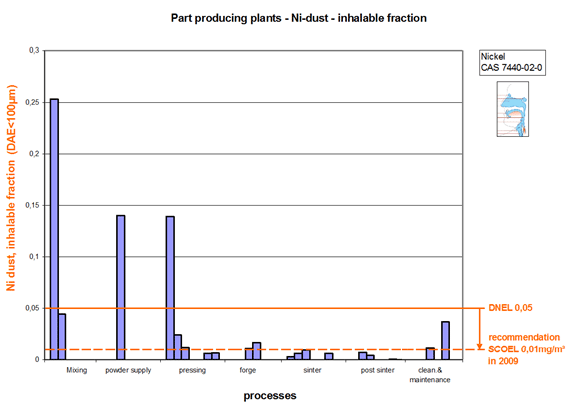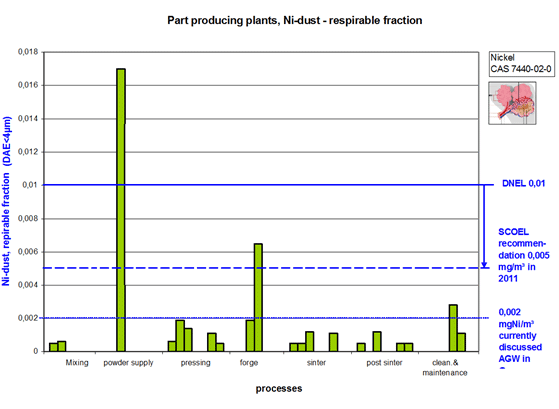2012 Hagen Symposium: An insight into REACH regulations for Powder Metallurgy part manufacturers
The burden of proof for recording, evaluating and assessment of material data has been transferred by REACH from the authorities to industry. The new policy is “no data, no market”. As a consequence, all participants in the supply chain are responsible for securing human health and the environment with respect to the materials they produce or use.
Companies producing or using hazardous substances are obligated view with special diligence which materials should remain in their portfolio in the long term. The process of finding practical solutions for implementing REACH that are accepted in the market requires communication with competent partners in the supply chain.
Your role in the supply chain is important
The responsibilities that are imposed by REACH depend largely on the role of the company in the supply chain and the types of products it produces, uses, distributes or imports. Many work areas and procedures in a company are affected such as Quality Management, IT, Health Safety & Environment, products, materials, liability, documentation, communication.
The role of manufacturers of PM structural parts under REACH is usually that of a Downstream User (DU) as long as they do not produce powder mixtures themselves and distribute them. For powder producers and importers there are other regulations.
PM parts manufacturers should take care that all raw, operating and auxiliary materials come from EU suppliers or that the invoices are issued within the EU, otherwise they might incur the role of an importer with the associated REACH duties. Imports should always be made through an EU-based office of the manufacturer or an authorised reseller within the EU.
PM parts manufacturers are producers of products. A product is defined as an object which is given a spe-cial shape, surface or design which determines its function to a greater degree than the chemical composition. Products are not subject to registration under REACH. In their role as a DU, PM parts manufacturers have the duty to inform their customers about the use of Substances of Very High Concern (SVHC) in their products.
If the content of substances classified as SVHC in the product is greater than 0.1% by weight, the user must be informed immediately. The minimum requirement is the name of the substance and information about the safe handling of the product. This includes surface treatments such as zinc coatings containing CrVI compounds.
Handling nickel powder in the PM industry
Metallic nickel is classified as potentially carcinogenic, skin irritating and hazardous to water. Nickel particles with an aerodynamic diameter (DAE) of less than 100 microns (particle diameter less than 33.5 microns) are considered inhalable and if the DAE is less than 4 microns (particle diameter less than 1.34 microns) they are considered respirable.
Since the average particle size of the most widely used carbonyl nickel is less than 10 microns, nickel dust is inhalable and a fraction of about 1.5% of the particles is respirable, i.e. it can even penetrate into the most delicate and most sensitive parts of the human lung, the aveolies.
EU member states are currently discussing new exposure limits for nickel dust. In order to contribute values of practical experience, GKN measured the nickel dust levels in various areas of its European production plants.
Fig. 1 shows that for the processing steps of powder mixing and pressing, the inhalable dust values can be clearly higher than the suggested “Derived No Effect Level” DNEL of 0.05 mg/m³. If this value is accepted as the legal limit, the PM industry will have to take additional Risk Management Measures (RMM) to minimise the inhalable dust levels. This includes improved dust control, the use of wet cleaning procedures, employing bonded powders, or eliminating or reducing the amount of carbonyl nickel powders used. The limit of 0.01 mg/m³ suggested in 2009 by the Scientific Committee on Occupational Exposure Limits (SCOEL) appears unrealistically low. It has been withdrawn after new insight from animal testing.
These animal tests were carried out with rats, and they showed that respirable nickel particles were not carcinogenic, but toxic on rats. Based on these tests SCOEL proposed an “Occupational Exposure Level” (OEL) for respirable nickel of maximum 0.005 mg/m³ in 2011. Fig. 2 shows that in many areas the PM industry is already below this extremely low level, but RMM is required particularly in powder supply and cleaning/maintenance.
Author: Dr Georg Schlieper, Gammatec Engineering GmbH, Germany
Dr.-Ing. Georg Schlieper, physicist, received his PhD at the Insitute for Materials and Solid State Research of the University of Karlsruhe, Germany. He worked for 15 years in product and process development for the Powder Metallurgy industry where he focused on high strength sintered steels, heat treatment, surface technology, magnetic materials and metal injection moulding. Since 1994 he has worked independently as a consultant. Email: [email protected]
News | Articles | Market reviews | Search directory | Subscribe to e-newsletter







